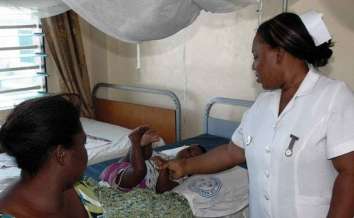New study about foreign educated nurses seeking work in the US sheds new light on global nurse migration trends

Historically, the United States (U.S.) has been a top receiving country of internationally educated nurses (IEN). These nurses had often worked in areas where there were significant nursing shortages. Therefore, U.S. was seen internationally as a major global contributor to a phenomenon of talent emigration known as nursing "brain drain", where locally educated nurses would go to school only to be seeking employment in the U.S., leaving their home country without adequate nursing talent and resources.
A new study, "Exploring longitudinal shifts in international nurse migration to the United States between 2003 and 2013 through a random effects panel data analysis," by a team of researchers at New York University Rory Meyers College of Nursing (NYU Meyers) examined a decade's worth of data about IENs seeking work in the U.S., and found some striking data which counter this past "brain drain" narrative.
A total of 177 countries were eligible for inclusion in the study, representing findings from 200,453 IEN applicants to the United States between 2003 and 2013. Their work found that changes to the NCLEX-RN licensure examination (2008), the global economic crisis of late 2008, and the passing of the World Health Organization's Code for Ethical Recruitment of Health Workers (2010), all played a part in the significant drop in IEN applicants.
"The data showed that the decrease in IEN applicants to the U.S. was this perfect storm, a confluence of all these factors," notes Allison Squires, PhD, RN, FAAN, NYU Meyers assistant professor of nursing, an expert in international nurse migration, and the lead author on the study. "For example, the NCLEX exam questions shifted to a more complex assessment of the test taker's knowledge and critical thinking abilities and were revised to include questions of laboratory test interpretation, delegation of work, and pathophysiology. This appears to have caused a significant drop in pass rates of IENs on the exam."
Also notable in their findings was the fact that 70% of applicants for the exam came from two countries, India and the Philippines, suggesting that the US may contribute to brain drain from those countries but not other ones. Applicants from the WHO list of "do not recruit" countries represented a small fraction of the sample, only 4%, and the number of applicants continues to decline. Pass rates of candidates from those countries averaged around 20%. If a country did not have English as an official language, then candidates were also less likely to pass the exam.
"Overall, the data is showing IEN pass rates on the NCLEX-RN have steadily declined over time from an average of 58% in 2004 to 32% in 2015," notes Dr. Squires. No significant changes were found in the number of candidates following the 2008 economic crisis or the 2010 WHO Code.
The researchers note that the results from the study suggest that if IENs are going to be successful in their efforts to migrate, they may need transitional education programs to pass the NCLEX exam. Transitional education programs are offered by many countries and sometimes organizations. These programs help prepare the candidate to take the exam and when appropriate, help build communication skills in ways that optimize patient safety.
Even graduates from schools in "sending countries" that are designed to produce professionals for export and not necessarily to work in their home countries may still need these programs to pass.
The researchers also reported that how international nurse recruitment was conducted in the past in the U.S. is unlikely to be repeated in the future, even in the 16 U.S. states that are forecasted by Health Services and Resources Administration (HRSA) to have critical nursing workforce shortages.
"Before, anyone could set up a nurse recruitment business and odds were, candidates could get successfully placed," comments Dr. Squires. "A lot of people made a lot of money in the industry before the global economic crisis caused the industry to collapse. Now, with changes in the visa allocation process for nurses and what this study's results show, the chances of an IEN successfully entering the U.S. labor market without a transitional education program is decreasing."
Overall, this study suggests that, while the WHO Code has had an influence on overall IEN migration dynamics to the United States by decreasing candidate numbers, in most cases, the WHO Code was not the single cause of these fluctuations. Indeed, the impact of the NCLEX-RN exam changes appears to exert a larger influence.
More information: Allison Squires et al. Exploring longitudinal shifts in international nurse migration to the United States between 2003 and 2013 through a random effects panel data analysis, Human Resources for Health (2016). DOI: 10.1186/s12960-016-0118-7















